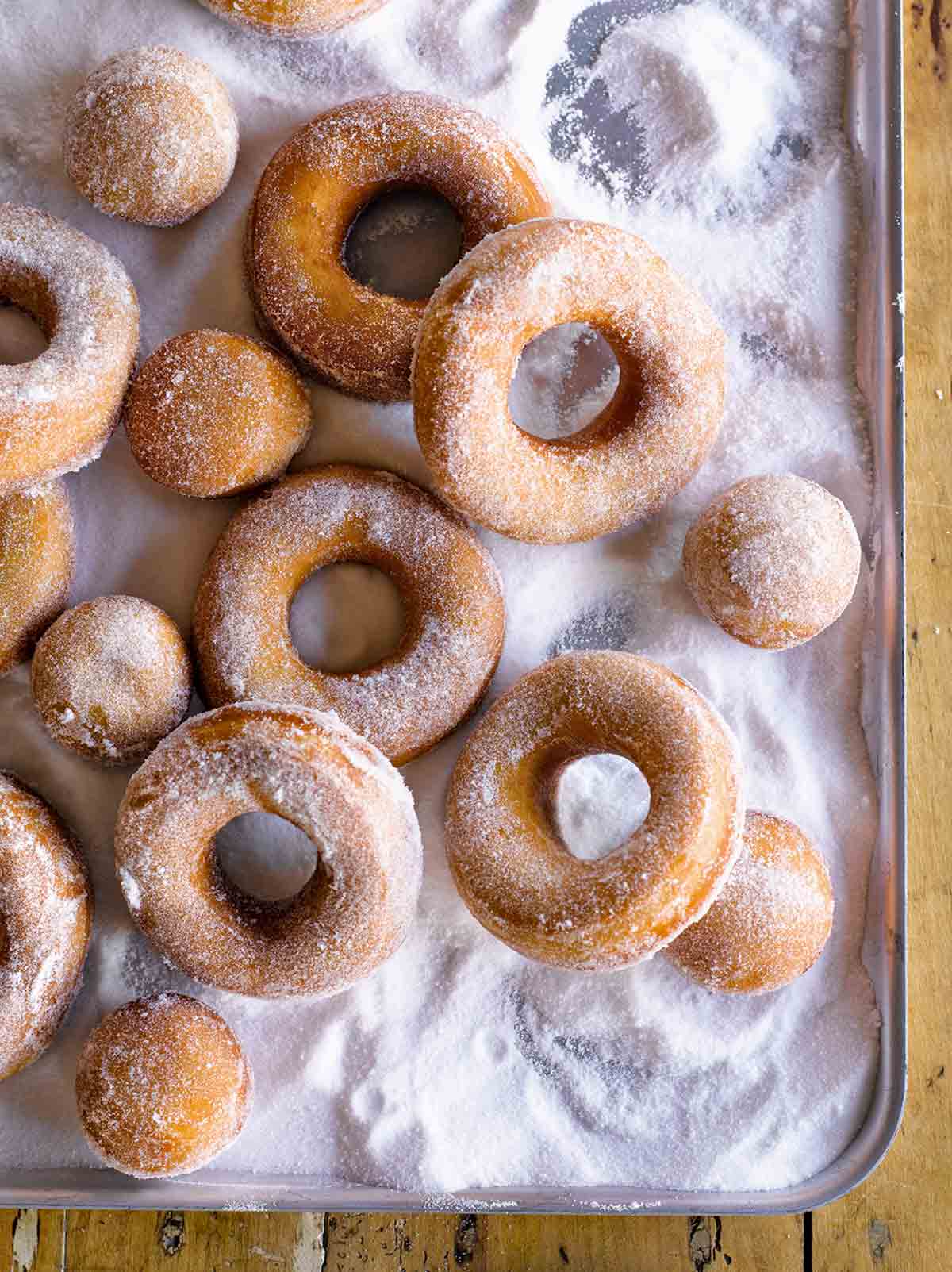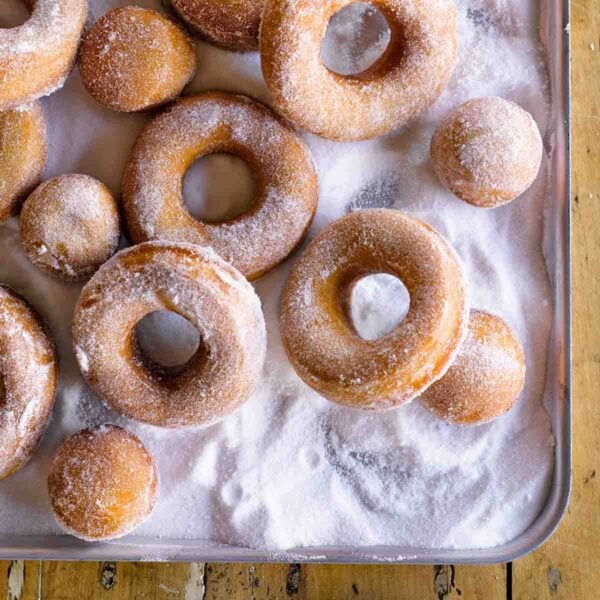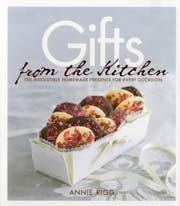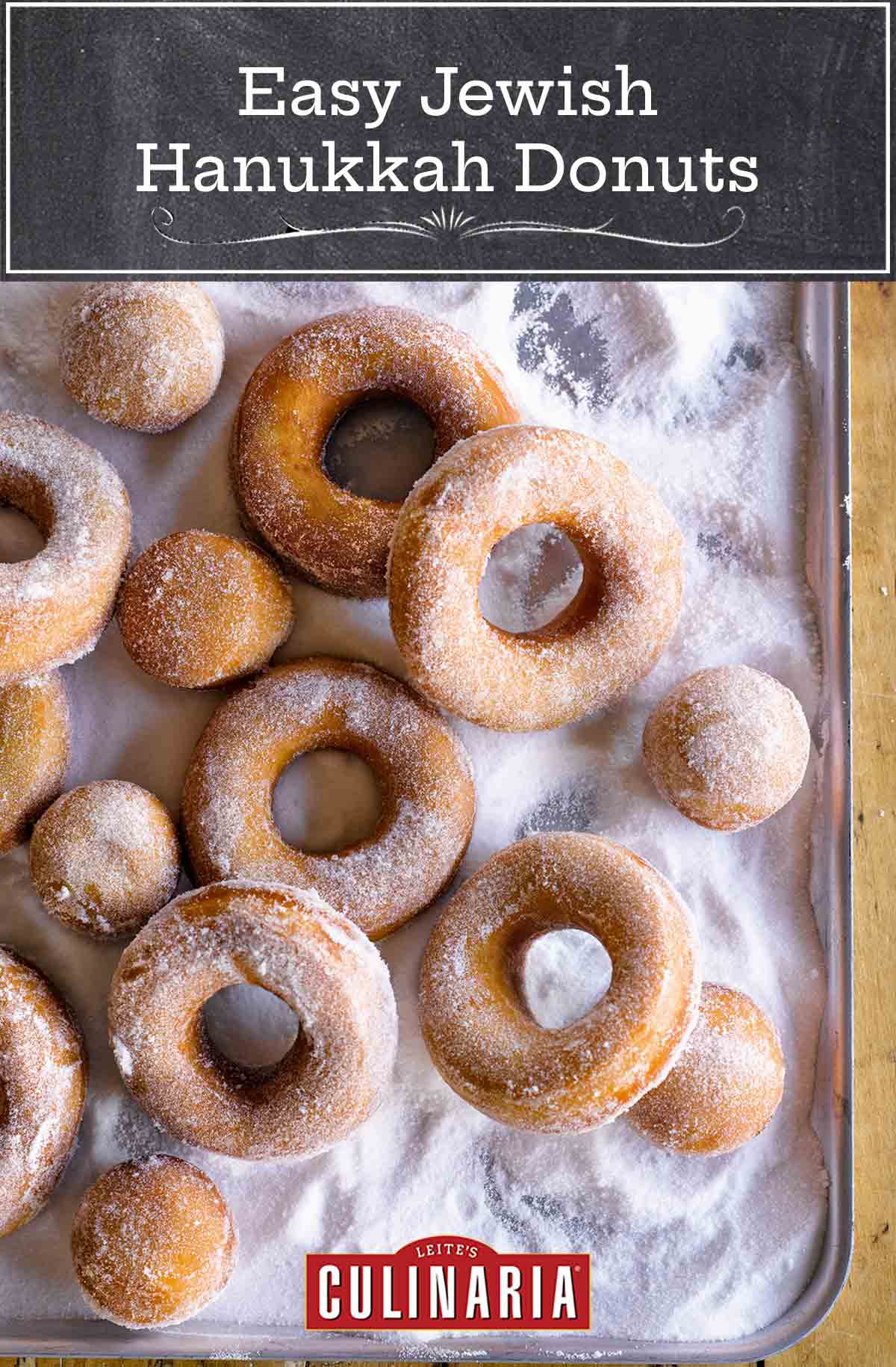
If you have never eaten freshly cooked, homemade doughnuts, then you’ve missed out on something stupendously delicious. Doughnuts are a common Hanukkah treat, when it is traditional to eat fried foods that symbolize the miracle of the oil that was found in the temple in Jerusalem that burned for eight nights rather than for one.—Annie Rigg
Easy Jewish Hanukkah Doughnuts FAQs
These treats are best eaten on the day they are made but they can be stored at room temperature in a plastic zipper-sealed bag for another two days. A few seconds in the microwave will help to give them a little life on days two and three.
You can add a little bit of zip to the dipping sugar with a bit of cinnamon, nutmeg, pumpkin pie spice mix, or anything else you fancy.
Annie Rigg recommends sunflower oil but you have other options. Oil for deep-frying needs to have a high smoke point but you also want something affordable, since you’ll be using a lot of it. Canola, safflower, and peanut oil are all mild-tasting oils that are good options.

Easy Jewish Hanukkah Doughnuts
Ingredients
- 3/4 cup whole milk
- 1 1/2 envelopes active-dry yeast
- 3 1/4 cups bread flour, plus more for the work surface
- 1/2 teaspoon salt
- 1 2/3 cups superfine sugar, (or just blitz granulated sugar in a blender until finely ground but now powdery)
- 1 whole egg, beaten
- 1 egg yolk
- 2/3 stick unsalted butter, at room temperature
- 1 quart sunflower oil, for deep frying
- 1 teaspoon ground cinnamon, (optional)
Instructions
- Heat the milk until warm to the touch. Add the yeast and whisk to combine, then set aside in a warm place for about 5 minutes to activate the yeast. You’ll know it’s ready when the milk has a thick, yeasty foam floating on top.
- Pour the flour, salt, and 1/3 cup of the sugar into the bowl of a standing electric mixer equipped with a dough hook. Make a well in the center and add the yeasty milk mixture, the whole egg, egg yolk, and butter. Mix steadily for about 5 minutes, until the dough is smooth and elastic. It will still be slightly sticky.
- Dust a work surface with a little flour, then scrape the dough out of the bowl and onto the flour. Knead the dough, using your hands, for 1 minute. Shape the dough into a smooth ball and place it in a large, clean bowl. Cover with plastic wrap and leave in a warm, draft-free place until the dough has doubled in size, at least 1 hour.
- Lightly dust the work surface with flour again and knead the dough very gently for 1 minute. Roll it out to a thickness of 1/2 inch. Using a round cookie or biscuit cutter, stamp out discs from the dough (roughly 2 1/2 to 3 1/2 inches in diameter). Using a smaller cutter (about 1 1/2 inches), stamp out a smaller disk from the middle of each doughnut.
- Arrange the ring doughnuts and mini round doughnuts (that is to say, doughnut “holes”) on a lightly floured baking sheet. Cover loosely with oiled plastic wrap and let rise again for 30 minutes.
- Cover a large baking sheet with a triple thickness of paper towels and pour the remaining superfine sugar into a large bowl or shallow roasting pan. Pour the sunflower oil into a large, shallow pan (it should come halfway up the sides) and heat to 350°F to 375°F (180°C to 190°C).
- Fry the doughnuts in small batches for about 1 to 2 minutes on each side, until lightly browned. Remove from the oil with a slotted spoon and drain thoroughly on the paper towels before tossing in the superfine sugar. Make sure the oil comes back up to temperature before frying the next batch of doughnuts. Eat while warm.

Explore More with AI
Nutrition
Nutrition information is automatically calculated, so should only be used as an approximation.
Recipe Testers’ Reviews
This is an EXCELLENT dough recipe for yeast doughnuts and will be my go-to standard for now on, well past the holidays. The resulting doughnuts are tender but didn’t deflate when I took a bite. There is a big open crumb inside that maintains its firmness.
I tested them as per the recipe, with the holes punched out in the traditional doughnut shape and dusted with sugar, but the second batch (they were that good) I kept whole. I liked them better this way, and after the holidays, as a hole-less doughnut I could add FILLINGS—Nutella, ricotta cheese with honey, or fig preserves are some grown-up fillings I like with homemade doughnuts. Yum!











